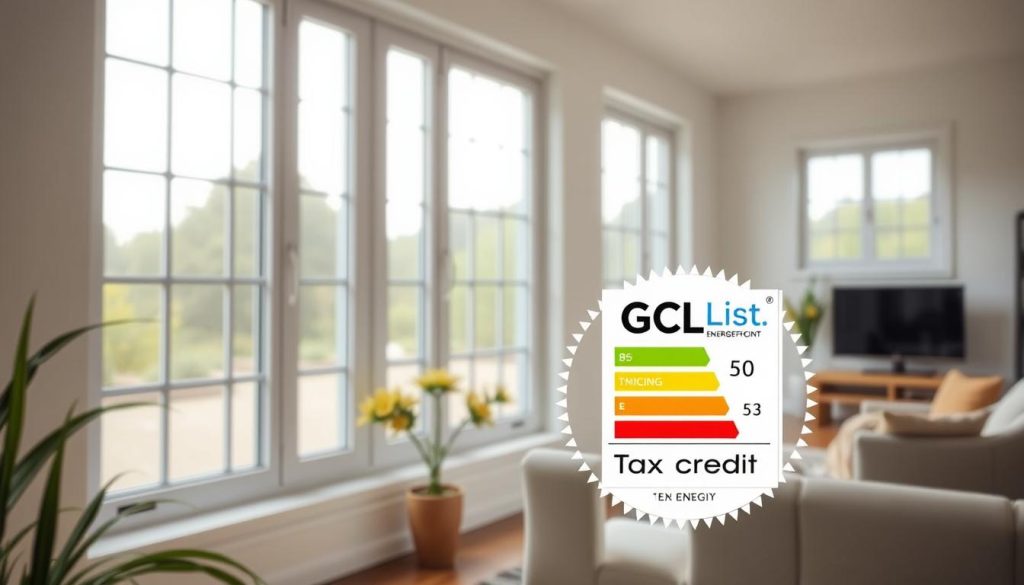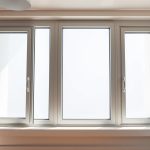Did you know you can get a tax credit of up to $600 for energy-efficient windows and skylights? This can cut down on energy use and lower your bills. It’s part of the energy tax credit for new windows, also known as the energy efficient windows tax credit or window replacement tax credit1.
The energy tax credit for new windows is a government incentive. It encourages homeowners to get energy-efficient windows and skylights. The tax credits for 2023 have been extended to 2032 by the Inflation Reduction Act of 20222.
Homeowners can get a tax credit of 30% for energy-efficient improvements under IRC Section 25C. The maximum annual credit cap is $1,200 for all qualifying expenses. Some high-efficiency items can have a cap of $2,0001.
The federal government offers tax credits to help with energy-efficiency costs. These credits are not cash rebates. There are tax credits for roofs, solar systems, windows, doors, skylights, insulation, biomass heaters, air conditioning, water heaters, electric vehicles, geothermal heating, and wind turbines2.
Key Takeaways
- Homeowners can claim a tax credit of up to $600 for energy-efficient windows and skylights.
- The energy tax credit for new windows is a government incentive to encourage energy-efficient investments.
- The tax credits currently in place for 2023 have been extended through 2032.
- Homeowners can claim 30% of costs for insulation and air sealing with no specific cap.
- The credit remains available through December 31, 2032.
- Homeowners can find more information and claim their Government Green Rebates at GCList, the premier directory for trustworthy local general contractors.
What is the Energy Tax Credit for New Windows?
The energy tax credit for new windows is a government effort to boost energy efficiency and cut carbon emissions. Homeowners can get a credit of up to $600 for energy-saving windows and skylights. This can lower energy use and utility bills3. It’s for primary homes like single-family houses, townhouses, and condos.
The new windows energy rebate program and tax credit for energy saving windows aim to get homeowners to choose energy-efficient windows. This way, they can cut down on energy use and get a window upgrade tax deduction of up to $1,2004. For more details, visit the US Department of Energy website or talk to a local contractor.
Homeowners can also check out the GCList website for more on the new windows energy rebate program and other incentives. Using these programs can save money on energy bills and help the environment5.
Eligibility Requirements for the Energy Tax Credit
To get the energy tax credit for new windows, homeowners need to meet certain rules. The credit is for main homes like single-family houses, townhouses, and condos. Windows must be Energy Star Most Efficient to qualify, needing to be energy-saving, durable, and perform well6.
Homeowners can check the Energy Star website for eligible windows and skylights. The credit can be up to $1,200 per year for windows installed between January 1, 2023, and January 1, 20336.
The federal tax credit for energy-efficient windows can lower the cost of installing them. Homeowners can get 30% of the cost back, up to $6007. This applies to installations from January 1, 2023, to January 1, 20338. Windows must meet Energy Star Most Efficient standards6.
Some important things to remember when applying for the energy tax credit include:
- Home energy audits qualify for a credit of $1506
- Exterior doors have a limit of $250 per door, with a total limit of $5007
- Exterior windows and skylights have a total limit of $6008
Homeowners can visithttps://www.improveitusa.com/blog/faq-energy-tax-credit-for-new-windows/to learn more about the energy tax credit for new windows. For more information on energy-efficient window installations, homeowners can visit https://gclist.us to find qualified contractors who can help with energy-efficient window installations.
How to Claim the Energy Tax Credit
To get the energy tax credit for new windows, homeowners need to follow a few steps. First, they must check if the windows and skylights qualify. Then, they need to collect receipts, invoices, and certification statements from the manufacturer.
Next, they have to fill out Form 5695 to claim the credit9. If they’re unsure, they can talk to a tax expert or call the IRS for help.
The energy tax credit for new windows is a big help. It lets homeowners claim up to 30% of the cost of energy-saving upgrades. There’s a yearly limit of $1,200 for the first category of upgrades9.
They can also get a credit for energy-efficient windows. The yearly maximum credit is $60010. Homeowners can claim this by filing Form 5695 with their tax returns10.
It’s important to know that this credit is for primary residences only11. Homeowners can claim it on their federal tax return for the year they made the upgrades. They usually file in March or April of the next year9.
For more details, homeowners can visit GCList or talk to their local contractor. They can learn about the tax benefits and credits for energy-efficient windows and doors.
Homeowners can also use other incentives to save more money. Claiming the Energy Efficient Home Improvement Tax Credit doesn’t stop them from getting other rebates9. This credit is only for upgrades to existing homes, not new ones11.
By using the energy tax credit for new windows, homeowners can save a lot on energy and taxes. It’s a smart choice for those looking to make their homes more energy-efficient.
Financial Impacts of the Energy Tax Credit
The energy tax credit for new windows can have big financial benefits for homeowners. The IRS says homeowners can save up to $600 on their taxes12. This is part of a bigger credit for energy-saving home improvements, covering up to 30% of costs, with a max of $3,200 until 203212. There’s also a special credit for energy-efficient windows.
Energy-efficient windows and skylights offer long-term savings too. They help cut down on energy use and lower bills. This credit makes these upgrades more affordable. Homeowners can check out https://gclist.us to see how they can save.
Some main perks of the energy tax credit are:
- Up to $600 in tax savings for energy-efficient windows13
- 30% of the cost of improvements, with a maximum of $3,200 valid through 203212
- Reduced energy consumption and lower utility bills
Frequently Asked Questions About the Tax Credit
Homeowners often wonder about the energy tax credit for new windows. They might think it’s only for new homes, but it’s for any primary residence14. The credit is for homes improved from January 1, 2023, to December 31, 203214.
The tax credit covers 30% of the cost of energy-saving upgrades, up to $1,200 a year15. For exterior windows and skylights, it’s 30% of the cost, up to $60015. For more details, call 279-777-6529. The IRS says it’s for single-family homes, townhouses, and condos14.
Here are some important points about the energy tax credit for new windows:
- The credit is for any primary residence, including existing homes14.
- The credit is 30% of the cost of upgrades, up to $1,200 a year15.
- The credit is for improvements made from January 1, 2023, to December 31, 203214.
For more info, visit the IRS website or talk to a tax expert16. This tax credit helps homeowners save money and make their homes more energy-efficient15.
Tips for Choosing Energy-Efficient Windows
Choosing the right energy-efficient windows is important. Look for windows that meet the Energy Star Most Efficient criteria. These windows must be energy efficient, durable, and perform well17. The new windows energy rebate program and tax credit for energy saving windows can help with costs18. You can also claim a window upgrade tax deduction for eligible improvements19.
When selecting windows, consider features like low U-factors and low solar heat gain coefficients. Also, look for gas-filled windows with low-e coatings17. The ENERGY STAR label shows a window’s energy efficiency. NFRC ratings help compare energy performance17. Visit the Energy Star website to find eligible windows and skylights. The GCList website can help you find qualified contractors for installations.
Here are some popular brands and energy ratings to consider:
- Energy Star certified windows with a U-factor of 0.30 or less
- Windows with a solar heat gain coefficient of 0.40 or less
- Gas-filled windows with low-e coatings and a U-factor of 0.20 or less
Choosing energy-efficient windows can lower your energy bills and make your home more comfortable18. It’s also important to have them installed by trained professionals. This ensures they work efficiently and keeps warranties valid17.

Contact Information for More Assistance
Homeowners looking for help with the energy tax credit for new windows can reach out to GCList20. The IRS offers a tax credit of up to $600 for energy-efficient windows and skylights. This credit helps homeowners save on energy, lower bills, and support a greener future.
For personalized help, homeowners can email [email protected] or call 279-777-6529. The GCList website at https://gclist.us has lots of useful info. It includes details on how to apply, what products qualify, and other government incentives21. Talking to a tax expert or the IRS can also ensure homeowners get the most from the credit.
With GCList’s help, homeowners can understand the energy tax credit better22. They can make smart choices about improving their homes’ energy efficiency. The right advice can lead to financial benefits and long-term savings.
FAQ
What is the energy tax credit for new windows?
The energy tax credit for new windows is a government incentive. It encourages homeowners to get energy-efficient windows and skylights. This credit can cut down on energy use and lower utility bills.
How much is the energy tax credit for new windows?
This credit is a non-refundable tax credit. Homeowners can claim up to 0 for energy-efficient windows and skylights.
Who is eligible for the energy tax credit for new windows?
The credit is for primary residences like single-family homes, townhouses, and condos. Eligible windows must meet Energy Star Most Efficient criteria. This includes energy efficiency, durability, and performance.
How can homeowners claim the energy tax credit for new windows?
Homeowners must follow a step-by-step application process. They need to gather important documents and file Form 5695.
What are the financial impacts of the energy tax credit for new windows?
The credit can make energy-efficient windows and skylights more affordable. It offers long-term benefits like lower energy use and bills.
What are some common misconceptions about the energy tax credit for new windows?
Some think the credit is only for new construction. But it’s available for primary residences, including existing homes.
What should homeowners look for when choosing energy-efficient windows?
Look for windows that meet Energy Star Most Efficient criteria. This includes energy efficiency, durability, and performance. Also, check out popular brands and energy ratings for better choices.
Where can homeowners find more information and assistance?
Homeowners can call GCList at 279-777-6529 or visit https://gclist.us for more info. The Energy Star website and the IRS website also offer resources and support.
Source Links
- https://www.bakertilly.com/insights/understanding-sections-25c-and-25d-for-energy-efficient-home-improvements
- https://www.constellation.com/energy-101/homeowners-guide-tax-credits-and-rebates.html
- https://www.kiplinger.com/taxes/605069/inflation-reduction-act-tax-credits-energy-efficient-home-improvements
- https://www.energystar.gov/about/federal-tax-credits
- https://www.irs.gov/credits-deductions/home-energy-tax-credits
- https://turbotax.intuit.com/tax-tips/home-ownership/energy-tax-credit-which-home-improvements-qualify/L5rZH56ex
- https://www.nerdwallet.com/article/taxes/energy-efficient-home-improvement-credit
- https://www.investopedia.com/terms/e/energy-tax-credit.asp
- https://www.cleanenergyconnection.org/article/guide-energy-efficient-home-improvement-tax-credit
- https://www.pella.com/performance/energy-efficiency/energy-tax-credits-for-windows-doors/
- https://green-living.na.panasonic.com/articles/home-energy-tax-credits-how-they-work-who-is-eligible-how-to-claim-them
- https://wilkecpa.com/energy-tax-credits-for-2024/
- https://www.irs.gov/newsroom/irs-home-improvements-could-help-taxpayers-qualify-for-home-energy-credits
- https://www.irs.gov/credits-deductions/frequently-asked-questions-about-energy-efficient-home-improvements-and-residential-clean-energy-property-credits
- https://www.currentfederaltaxdevelopments.com/blog/2025/1/17/irs-issues-updated-energy-efficient-home-improvement-credit-and-the-residential-clean-energy-property-credit-frequently-asked-questions
- https://www.energy.gov/sites/default/files/2023-02/Tax Credit Table.pdf
- https://www.energy.gov/energysaver/update-or-replace-windows
- https://www.irs.gov/credits-deductions/energy-efficient-home-improvement-credit
- https://www.energystar.gov/about/federal-tax-credits/windows-skylights
- https://www.energy.gov/save/home-upgrades
- https://www.michigan.gov/egle/about/organization/materials-management/energy/rfps-loans/home-energy-rebate-programs
- https://www.naperville.il.us/services/electric-utility/powering-our-community-for-the-future/energy-efficiency-grant-programs/residential-energy-efficiency-incentives/


